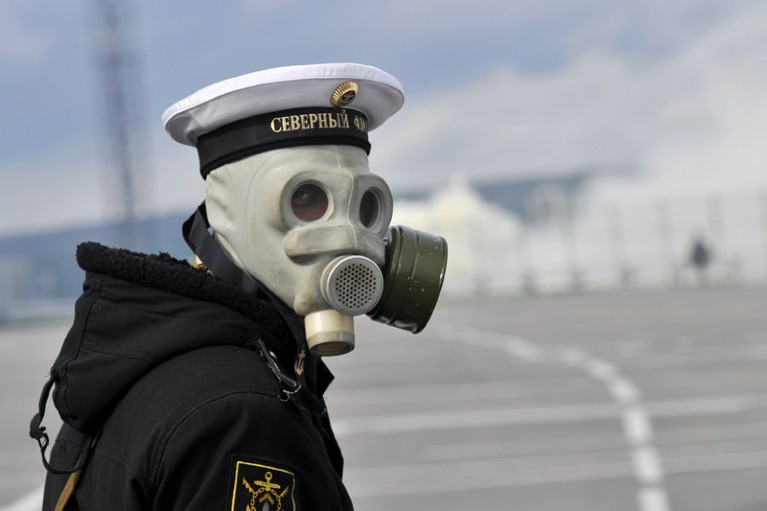
A serviceman from Russia’s chemical, radiological and biological weapons defence unit in 2016.Credit: Lev Fedoseyev/TASS/Getty
Biosecurity in Putin’s Russia Raymond A. Zilinskas & Philippe Mauger Lynne Rienner: 2018.
Regimes of all types throughout history have sought to harness science for war. As a result, otherwise beneficial technology can become ‘dual-use’. Biological weapons are among the starker examples: research meant to save lives is used to take them. Now, in the run up to elections in Russia, and with concerns mounting about the nation’s role globally, biological-weapons specialists Raymond Zilinskas and Philippe Mauger deliver Biosecurity in Putin’s Russia.
Bioweapons research in Russia and its environs extends back as far as 1928. It took off in the 1970s, for example through the infamous clandestine Biopreparat network. There, the Soviets weaponized pathogens including the smallpox and Marburg viruses and the anthrax bacterium Bacillus anthracis. Zilinskas and Mauger focus on the years 2012–16, when political tensions between Russia and the West intensified markedly. Concerned by apparent shifts in Russia’s pronouncements and actions regarding dual-use activities related to biosecurity, Zilinskas and Mauger write that they wish to “move the discussion over Russian compliance concerns to the public sphere”, where an evaluation based on evidence becomes possible.
They investigate — solely through open sources — the current Russian position. They especially dig into issues such as “genetic weapons” (bioweapons aimed at damaging DNA, potentially of specific individuals or groups) and biodefence research. Their underlying intention throughout seems to be to examine the likelihood that the Russian government is itself willing to engage in banned activities related to biowarfare agents. The book thus becomes a technical-scientific detective story.
Zilinskas and Mauger cover a lot of ground, from Russia’s current biodefence infrastructure to its diplomatic and propagandistic activities in the context of the 1972 Biological Weapons Convention (BWC). There is plenty of suggestive material. They show that, at least according to internal doctrinal documents, Russia’s ostensible rejection of new research on bioweapons is equivocal. At the same time, the Putin regime has ramped up its disinformation campaign aimed at insinuating that the United States is not complying with the BWC, thus providing a possible pretext for its own research into banned areas. This is occurring, the authors remind us, against the backdrop of a largely intact biosecurity infrastructure (encompassing Biopreparat, multiple military facilities and other entities). Meanwhile, the civilian biotechnology sector is floundering, and so might become vulnerable to co-option by the military.
Readers expecting a smoking gun (or festering Petri dish) will be disappointed. The authors do not give any information about specific pathogens or tools under development. What they do present is a meticulous, exhaustively researched and extensively cited investigation. The sources on which Zilinskas and Mauger draw range from arcane technical publications (such as a 2008 military tender for infrastructure improvements) to unofficial propaganda, satellite data, official pronouncements and published interviews; one is with the former head of Russia’s military Biological Defense Department, Valentin Yevstigneev.
Zilinskas and Mauger apply innovative methods to routine data. For instance, they cross-reference lists of institutes with publications by scientists at those institutes; this yields illuminating inferences, such as signs that one body might have shifted from above-board scientific publishing to classified work. They also usefully explain the background to treaties and protocols, and conscientiously distinguish between solid fact and their own opinion throughout.
The book has weak points. Although it is well-written and engaging, the detail can become ponderous: more than 100 pages are devoted to military and civilian facilities connected to Russian biodefence. A more judicious use of examples, with the remainder relegated to appendices, would have been preferable to repetitive lists.
The book is also short on synthesis. Like the proverbial blind men describing an elephant, the many chapters answer distinct parts of the central question but fail to tell a coherent story. For example, Zilinskas and Mauger do not explicitly link the Russian establishment’s apparent growing willingness to research “weapons based on new physical principles” — which is likely to include biological agents — to its increasingly vehement accusations that the United States is engaging in dubious biological research. Instead, the authors’ vague policy prescriptions to the US government seem out of place.
Outright allegations might have undermined the authors’ carefully marshalled facts and dispassionate analysis. But this indeterminacy is like watching a prosecutor present a stack of circumstantial evidence, then walk out of the courtroom without delivering a closing argument. The authors’ case might be circumstantial, but it is a strong one. A forceful concluding chapter —with appropriate caveats about speculation versus fact — might have done the reader a great service. (My guess — and it is just a guess, because there is no hard evidence — is that Russia is capable of working on any pathogen, with any technique, from CRISPR gene-editing to gain-of-function research.)
Ultimately, these are minor quibbles regarding this trove, which will be new to the world outside Russia. The scholarship and cogent analysis in Biosecurity in Putin’s Russia are formidable, as rigorous as any assessment of the country’s biological-warfare capability by the world’s best intelligence agencies. The book is overall a fascinating reflection of the complex web of interests and institutions that have converged to drive Russia’s current orientation towards biosecurity. As tensions between the West and Russia grow, questions are bound to arise about Russia’s capacities and proclivities for biological weapons. Governments, the non-proliferation community, scientists and institutions involved in international collaborative research should begin looking for their answers here.

 Rethink biosafety
Rethink biosafety
 The USSR's deadly secret
The USSR's deadly secret
 Take Russia to 'task' on bioweapons transparency
Take Russia to 'task' on bioweapons transparency








